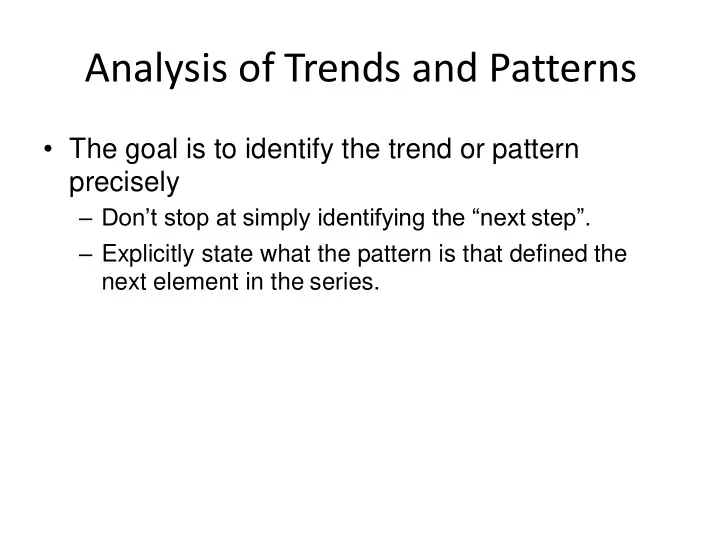

Analysis of Trends and Patterns • The goal is to identify the trend or pattern precisely – Don’t stop at simply identifying the “next step”. – Explicitly state what the pattern is that defined the next element in the series.
Sample Problems • A B A C A D A E • 3 4 6 7 9 10 12 13 15 16 • 2 7 4 9 6 11 8 13 • 1 z 3 w 9 t 27 q 81 • JKLMNO JKLMON JKLOMN JKOLMN
Jars Problem You have 3 jars, of sizes 11 quarts, 9 quarts, and 4 quarts. You would like to use these jars to collect 6 quarts of water in one jar. How? A B C Goal A – B + C 11 9 4 6 21 127 4 98 15 90 4 67 14 163 25 99 18 43 10 5 9 43 6 22 20 59 4 31 14 36 8 6 28 76 3 25
Don’t be Blind • For most problems, people use a relevant strategy from habit. – There’s an excellent reason for this: It usually works!! • Sometimes, the habit strategy is a bad match for the problem. • In this case, people can act like they are “blind” to the solution. • Example: Water jar problem.
Einstellung • “Einstellung” is the state of being “blind” or “tuned - in” to something. • “Functional Fixedness” : People often fail to see alternate uses to an object once they assign it a role. • People are fairly predictable in their susceptibility to functional blindness. • Awareness of the problem helps to avoid it. • This is real issue for students and in “real life” – Example: Debugging, algorithm design
Lateral Thinking • “Vertical thinking” is sticking with the current approach, being rigid. • “Lateral thinking” is coming at a problem from a different (perhaps nonstandard) direction. • Often, just realizing that this should be done is enough to find a good solution (getting out of the old approach). • Of course, it can be hard to tell when you are in the trap! It helps to have a “flexible” mindset.
Examples of Lateral Thinking • Unsticking a car lock on a cold night – Approach 1: Heat the key – Approach 2: Unfreeze the lock (with alcohol) • Need to iron a shirt, but no iron – Iron with something else (a frying pan) • Sheep in front of the truck – Approach 1: Beep horn, try to push or scare sheep – Approach 2: Lead the sheep behind the truck
How to Facilitate Flexibility? • Brainstorming (Chapter 6 in Fogler/LeBlanc) – Generate ideas – Usually done in groups – Don’t judge – respect crude ideas – Quantity is important • Brainstorming is a skill that can be developed - Skills are developed by practice A contrary view: D. Boyd and J. Goldenberg, “Inside the Box: A Proven System of Creativity for Breakthrough Results,” Simon & Schuster, 2013.
The Intermediate Impossible • For really hard problems • Generate an impossible solution • “Play with” that solution – Expand on it, modify it • Thus, the “impossible” solution is an intermediate step to a feasible solution
Example Problems • Unloading cargo ships takes a long time. – Unload at sea? • New (taller) cargo ships cannot enter a port city due to a bridge. – Lower river? • A factory dumps pollution into a river. – If the factory had to suffer from the pollution, they would be motivated to clean it up. So, put factory intake downstream from factory discharge?
Random Associations • Pick an (interesting) word out of the dictionary. • Let it stimulate your mind. • Problem: Noise pollution • Word: Anthracite – Comes from under ground • Put noise underground? • Put quiet places underground? – Black • Eyelids cover eyes… cover ears?
Analogies and Metaphors • Many inventors take analogies from nature – Tunnels underwater: worms tunneling in wood – Microphone (for telephone) from the ear – Infection cause deduced from observing fermentation of wine – Spider nets lead to fishing nets
Sleep On It • Passage of time can unstick many problems. • The mind “incubates” the problem. – Perhaps works on problem unconsciously. • Each of us has circumstances in which we are most creative: – lying in bed, taking a shower, waiting for an appointment. – Take advantage of this. • Must give yourself time to solve the problem. • Example: debugging a computer program.
Sleep On It (cont) • It gives you a chance to come at the problem with another approach – Does the solution occur to you? – Perhaps a new approach that immediately leads to the solution? • Promotes (allows) lateral thinking
Recommend
More recommend